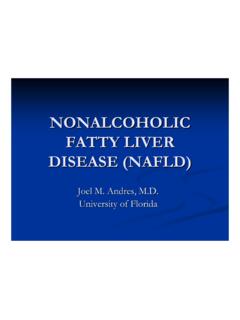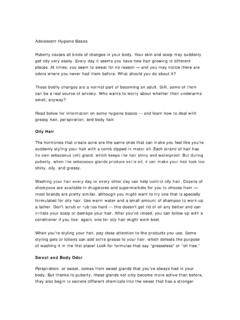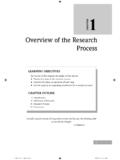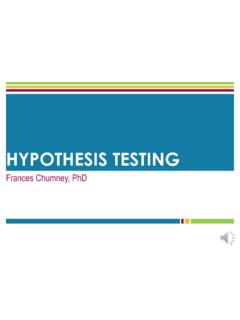Transcription of Types of Data Descriptive Statistics
1 1 Statistical Methods ITamekia L. Jones, Assistant ProfessorChildren s Oncology Group Statistics & Data Center Department of Biostatistics Colleges of Medicine and Public Health & Health ProfessionsOutline of TopicsI. Descriptive StatisticsII. hypothesis testing III. Parametric Statistical TestsIV Nonparametric Statistical Tests2IV. Nonparametric Statistical TestsV. Correlation and RegressionTypes of Data Nominal Data Gender: Male, Female Ordinal Data Strongly disagree, Disagree, Slightly disagree, Neutral, Slightly agree, Agree, Strongly agree3,gyg,g,gyg Interval Data Numeric data: Birth weight Descriptive Statistics Descriptive statistical measurements are used Descriptive statistical measurements are used in medical literature to summarize data or describe the attributes of a set of data Nominal data summarize using /i4rates/proportions.
2 % males, % females on a clinical studyCan also be used for Ordinal data 2 Descriptive Statistics (contd) Two parameters used most frequently in clinical medicine Measures of Central Tendency Measures of Dispersion 5 Measures of Central Tendency Summary Statistics that describe the Summary Statistics that describe the location of the center of a distribution of numerical or ordinal measurements where- A distribution consists of values of a characteristic and the frequency of their occurrence 6 Example: Serum Cholesterol levels (mmol/L) of Central Tendency (contd)Mean used for numerical data and forMean used for numerical data and for symmetric distributionsMedian used for ordinal data or for numerical data where the distribution is skewed7 Mode used primarily for multimodal distributionsMeasures of Central Tendency (contd)Mean (Arithmetic Average)8 Sensitive to extreme observations Replace with, say, new mean = / 9 = of Central Tendency (contd)Median (Positional Average) Middle observation.
3 The values are less than and half the values are greater than this observation Order the observations from smallest to Median = middle observation = Less Sensitive to extreme observations Replace with say New Median = of Central Tendency (contd)Mode The observation that occurs most frequently in the data Example: = Example: = ; 10 Two modes Bimodal distributionMeasures of Central Tendency (contd)Which measure do I use?Which measure do I use? Depends on two factors: 1. Scale of measurement (ordinal or numerical) and11)2. Shape of the Distribution of ObservationsMeasures of Central Tendency (contd)Shape of the distribution Symmetric Skewed to the Left (Negative)12 Skewed to the Right (Positive)4 Measures of Dispersion Measures that describe the spread or variation in the observationsthe observations Common measures of dispersion Range Standard Deviation Coefficient of Variation13 Coefficient of Variation Percentiles Inter-quartile Range Measures of Dispersion (contd)Range= difference between the largest and the ll t btismallest observation Used with numerical data to emphasize extreme values Serum cholesterol example14 Serum cholesterol exampleMinimum = , Maximum = = = of Dispersion (contd)
4 Standard Deviation Measure of the spread of the observations about the mean Used as a measure of dispersion when the mean is used to measure central tendency for symmetric numerical dataSt d d d i tilik thii l d t Standard deviation like the mean requires numerical data Essential part of many statistical tests Variance = s215 Measures of Dispersion (contd)Standard = = 9165 Measures of Dispersion (contd)If the observations have a Bell-Shaped Diib ithth f lliiltDistribution, then the following is always true -67% of the observations lie between 1 and 195% of the observations lie between 2 and 2 XsXsXsXs of the observations lie between 3 and 3 XsXs The Normal (Gaussian) DistributionMeasures of Dispersion (contd)Coefficient of Variation Measure of the relative spread in data Used to compare variability between two numerical data ddifflmeasured on different scales Coefficient of Variation (C of V) = (s / mean) x 100% Example: MeanStd Dev (s)C of VSerum Cholesterol (mmol/L) ()Change in vessel diameter (mm) of Dispersion (contd)Coefficient of Variation Measure of the relative spread in data Used to compare variability between two numerical data ddifflmeasured on different scales Coefficient of Variation (C of V) = (s / mean) x 100% Example.
5 MeanStd Dev (s)C of VSerum Cholesterol (mmol/L) Relative variation in Change in Vessel Diameter is more than 10 times greater than that for Serum Cholesterol ()Change in vessel diameter (mm) of Dispersion (contd) DiMaio et al evaluated the use of the test measuring maternal serum alphafetoprotein (for screening neural tube defects), in a prospective study of 34,000 women. Reproducibility of the test procedure was determined by repeating the assay 10 times in each of four pools of serum. Mean and s of the 10 assays were calculated in each of the 4 pools. Coeffs of Variation were computed for each pool: , , 2 7% and 2 4% These values indicate relatively , and These values indicate relatively good reproducibility of the assay, because the variation as measured by the std deviation, is small relative to the mean.
6 Hence readers of their article can be confident that the assay results were of Dispersion (contd)Percentile A number that indicates the percentage of the distribution ofA number that indicates the percentage of the distribution of data that is equal to or below that number Used to compare an individual value with a set of norms Example - Standard physical growth chart for girls from birth to 36 months of age For girls 21 months of age, the 95thpercentile of weight is 21gg,pgkg. That is, among 21 month old girls, 95% weigh kg or less, and only 5% weigh more than kg. 50thpercentile is the Median Measures of Dispersion (contd)Interquartile Range (IQR) Measure of variation that makes use of percentiles Difference between the 25thand 75thpercentiles Contains the middle 50% of the observations (independent of shape of the distribution) Example IQR for weights of 12 month old girls is the difference22 IQR for weights of 12 month old girls is the difference between kg (75thpercentile) and kg (25thpercentile); , 50% of infant girls at 12 months weigh between and kg.
7 hypothesis testing Permits medical researchers to make generalizations about a population based on results obtained from a study Confirms (or refutes) the assertion that the observed findings did not occur by chance alone but due to a true association between the dependent and independent variable23p The aim of the researcher is to demonstrate that the observed findings from a study are statistically significant. hypothesis testing (contd) Statistical hypothesis a statement about the value of a population parameter Null hypothesis (Ho ) Usually the hypothesis that the researcher wants to gather evidence against24 Alternative (or Research) hypothesis (Ha) Usually the hypothesis for which the researcher wants to gather supporting evidence 7 hypothesis testing (contd)Example: A researcher studied the relationshipExample: A researcher studied the relationship between Smoking and Lung CancerPresentAbsentSmokerAB25 Non-SmokerCDHypothesis testing (contd)Ho : There is no difference between smokers and nonsmokers with respect to the risk of developing lung cancer That iswith respect to the risk of developing lung cancer.
8 That is, the observed difference (in the sample), if any, is by chance alone. Ha : There is a difference between smokers and nonsmokers with respect to the risk of developing lung cancer and that the observed difference (in the sample) is not by chance 26(p) : If the findings of the study are statistically significant, then reject Ho and fail to reject the alternative hypothesis Ha. hypothesis testing (contd)Test Statistic Statistics whose primary use is in testing hypotheses are called test Statistics hypothesis testing , thus, involves determining the value the test statistic must attain in order for the test to be declared significant. 27 The test statistic is computed from the data of the testing (contd) Types of ErrorsTr ut hHoTr ueHoFalseDiiAccept HoCorrectType II error28 DecisionReject HoType I errorCorrect 8 hypothesis testing (contd) Type I Error Rejecting the null hypothesis when it is trueRejecting the null hypothesis when it is true If Ho is true in reality and the observed finding of a study is statistically significant, the decision to reject Hois incorrect and an error has been made.
9 Type II Error Failing to reject the null hypothesis when it is false. 29gjyp If in reality Hois false and the observed finding of a study is statistically not significant, the decision to accept Hois incorrect and an error has been made. hypothesis testing (contd)Alpha ( ) = Probability of Type I error; significance level of the test)Beta ( )= Probability of Type II errorBeta ( ) = Probability of Type II errorPower of a test = 1 ; probability that a test detects differences that actually exist; typically use 80%Level of Significance (p-value) in a study: Probability of obtaining a result as extreme as or more extreme than 30the one observed, if the null hypothesis is true Probability that the observed result is due to chance alone. Most researchers use p to reject Ho, and p> to accept the null hypothesis Hoand reject the alternative hypothesis testing (contd)OneSided Test of Hypothesisis one in which the alternativeOne-Sided Test of Hypothesisis one in which the alternative hypothesis is directional (typically includes the < symbol or the > symbol).
10 Two-Sided Test of Hypothesisis one in which the alternative hypothesis does not specify departure from the null in a ti lditi(t i llill bittith th 31particular direction (typically will be written with the Incidence of tuberculosis among Dade county (Miami) residents is known to be no more than (2 cases per 10,000 people) After conducting medical checks a medical researcherpeople). After conducting medical checks, a medical researcher believes that Haitian refugees arriving in Miami have a much higher incidence of tuberculosis. To check this belief, he will test the null hypothesis . 0: is the proportion of Haitians in Miami who contract 32 Versus the alternative hypothesis : he is interested in detecting whether the true incidence of TBin the HaaH itian population is Miami is larger than 9 Two-Sided A researcher would like to determine whether mean age of onset of heart disease in males differs from the mean age for females The null hypothesis of interest isfemales.)











